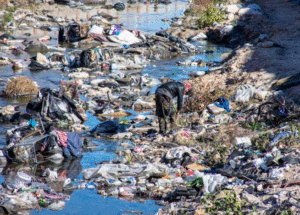Plastic litter, an almost unmanageable problem
For every euro paid for the production of plastic, society pays another nine for the damage it causes. In 2019, according to estimates worldwide, there were 2.8 trillion euros in so-called external costs that are not included in the price of plastics [Smit 2021]. This was the striking and alarming introduction to Pieter Hotse Smit’s article in the Flemish daily De Morgen. It refers to the Dahlberg study commissioned by the World Wide Fund for Nature [WWF 2021].

Take, make, use and dispose is no longer an option
Through innovation and advertising, the polymer industry has managed to sell us the “delights” of disposable plastics. The industry’s future is in the bin. Any product that is discarded has to be replaced, which ensures unending prosperity. To create one’s own exclusive production can be very profitable!
Meanwhile 7 billion tons of plastic waste have ended up in the environment. Also, it is estimated that between 10 and 20 million tons of plastic end up in the ocean every single year. One ton every second. Our planet is simply drowning in plastic pollution [Moisan 2021]. Without a sound plastic waste policy, there will be some 600 million tons in the sea by 2040.
Worst of all and most difficult to remove are the micro- and nanoplastics. They are not visible to the naked eye, but they are omnipresent [Miraj et al. 2021]. Peng et al. [2018] found that microplastic concentrations in the hadal bottom waters and sediment depths of the Mariana Trench (one of the most remote and deepest places on our planet) are extremely high. Moreover, Napper et al. [2020] found microplastics in snow and stream water on Mount Everest. So none of us will be surprised to read that micro- and nanoplastics are also present in our diets and in our bodies.
Environmental quality and therefore also health itself is deteriorating
The damage caused by plastics is mainly the result of its production. With fossil oil as the basic raw material, carbon dioxide is released during plastic synthesis. This will cause further global warming, which we need to avoid as much as possible.
After disposing of plastic waste, society pays for its collection and processing. Researchers reckon that picking up the rubbish from the sea represents the highest cost. Plastic that keeps floating in the water and gradually breaks down into microplastics will reduce marine biodiversity and stocks. As a result, the economic yield from the seas and oceans is decreasing.
Tourism is also suffering from stray plastic pollution, because tourists will obviously avoid highly polluted beaches and swimming waters.
In these study types, the cost estimate of ecosystem services can only be approximate and results are always subject to uncertainty. The actual contribution of plastic in the decrease in economic value of seas and oceans is uncertain. Moreover, we do not know how long plastics remain in the seas and what the exact consequences are for sea life. Major studies are still being carried out. However, this study [WWF 2021], as was the case with a number of previous studies, shows that the problem is “gigantic”.
We are only beginning to understand the impact of plastic on the environment. Yet, we know there is a huge discrepancy between the real cost of plastic pollution and what polluters are made to pay by way of compensation.
We need a new global treaty on marine plastic pollution
Scientists strongly recommend the need to urgently establish overarching control bodies [Wang et al. 2021; Monti et al. 2021; WWF 2021].
A new global treaty on marine plastic pollution would enable governments to tackle the plastic crisis and reduce the cost that plastic imposes on society. It could provide a well-designed framework encompassing global coordination of definitions, policies, reporting, and implementation support to accelerate the transition to a circular economy for plastic. Take, make, use and reuse should replace take, make, use and dispose.
When effective, it will act as a legally binding instrument that ensures accountability, thereby encouraging and enabling countries to take necessary steps to tackle the plastic crisis. Governments are beginning to respond. As of August 2021, a majority of the UN member states (104 countries) have explicitly called for a new global agreement. If a new treaty is to be established, governments will have to start negotiations through the adoption of a formal negotiation mandate at the 5th session of the UN Environment Assembly in February 2022.
There is still a lot of work to be done, but burying our heads in the sand and turning our backs on new initiatives is no longer acceptable.
References
Miraj et al. 2021]. Plastic microbeads: small yet mighty concerning, International Journal of Environmental Health Research 31, 7, in press
Moisan [2021]. Les Plastiqueurs, kero, pp. 339
Monti et al. [2021]. A new strategy for health and sustainable development in the light of the COVID-19 pandemic, Lancet 398, 10305, 1029 – 1031
Napper et al. [2020]. Reaching new heights in plastic pollution—preliminary findings of microplastics on Mount Everest, One Earth 3, 5, 621 – 630
Peng et al. [2018]. Microplastics contaminate the deepest part of the world’s ocean, Geochemical Perspectives Letters 9, 1 – 5
Smit [2021]. Schade door plastic ligt bijna tien keer hoger dan de prijs: wereldwijd 2,8 biljoen euro aan verborgen kosten, De Morgen, 6 september
Wang et al. [2021]. We need a global science-policy body on chemicals and waste, Science 371, 6531, pp. 3
WWF [2021]. Plastics: the costs to society, the environment and the economy, pp. 26
